Introduction
Persimmon (Diospyros kaki Thumb.) is globally grown and its production rate is increasing in the recent. Korea belongs to the countries that largely produce the persimmon in the world (1). Persimmon fruits are generally classified into non-astringent and astringent cultivars according to the presence of astringency at harvest (2). Astringent persimmons were mainly used for the production of processed products (3). For production of dried products, it is prequesite to find the ways how to maintain relevant firmness and reduce the physiological disorders at harvest and after storage as well.
A wide range of different postharvest treatments have been tried to maintain fruit quality using modified atmosphere packaging (MAP) (with different thick of polyethylene bags), and 1-methylcyclopropene (1-MCP), whereas MAP with 50-80 μm polyethylene film is widely used and delayed softening in fresh non-astringent persimmon (4). Similarly, 1-MCP could maintain fruit quality of the persimmon ‘Qiandaowuhe’ and ‘Tonewase’ during cold storage by inhibiting ethylene production (5,6). Likewise, aminoethoxyvinylglycine (AVG), an inhibitor of ethylene biosynthesis, also delays fruit ripening of peach (7) and apples (8,9). However, there has been almost no report describing about the combined effects of PE film liner bag with 1-MCP or AVG in the persimmon cultivar ‘Sangjudungsi’.
Harvest time also affected fruit longevity during cold storage in persimmon, but which is likely to be cultivar-dependent. In ‘Rojo Brillante’ persimmon, harvesting of fruit at late stage exhibited better quality than early harvested ones (10), while opposite results were observed in ‘Fuyu’ and ‘Hachiya’ cultivars (11). Hence, it is of interest to investigate influence of time of harvesting in fruit storage of this cultivar. Furthermore, it is also interesting to investigate the association between postharvest treatments and different harvest dates affecting fruit longevity during cold storage.
In this study, we investigated the effects of PE film liner, 1-MCP and AVG treatments on fruit quality attributes in ‘Sangjudungsi’ persimmon fruits during cold storage. In addition, the effect of different harvested dates in the same aspect was also evaluated.
Materials and Methods
The ‘Sangjudungsi’ persimmon fruit (Diospyros kaki Thumb.) was harvested at the commercial orchard in Sangju, Korea. The fruits were harvested at different harvest dates in 2015 and 2016. The fruits in 2015 were harvested at commercial harvest time on 20th October (mature stage). and the fruits in 2016 were picked up on 10th October, which was 10 days earlier than 2015. Harvested fruits were immediately transported to laboratory, and all the experiments were carried out at the postharvest laboratory of Horticultural Science, Kyungpook National University, Korea.
The fruit selected were uniform in shape and size, and free from decay and damage. The same treatments were immediately applied to harvested fruits before cold storage. For PE film liner treatment, polyethylene film liner bags (20 μm thick, Taebang Patec Co., Ltd., Seoul, Korea) were used to evaluate fruit storability. For 1-MCP treatment, 1 μL/L of 1-MCP (AgroFresh Co., Seoul, Korea) was used by fumigating the fruit for 18 h in an enclosed container. For AVG treatment, the fruit was dipped in the solution containing 75 mg/L of AVG (Valent BioScience, Libertvilles, IL, USA) for 5 min and dried for 1 h at ambient temperature. All the treatments were stored together at -1℃ in air with 90-95% relative humidity for up to 4 or 5 months of cold storage.
For the measurement of respiration rate and ethylene production, 3 fruits of each treatment were weighted and individually sealed in 1.6 L enclosed container for 1 h. Then, 1 mL of the headspace gas was injected into a gas chromatograph (GC-2010, Shimadzu Co., Tokyo, Japan) with flame ionization detector and activated column. Analyses were run at the oven temperature at 90℃ with the injector and detector temperature, respectively, 100℃ and 200℃ for both ethylene and respiration.
Peel color variables (L*, a*, and b*) were evaluated with a chromameter (CR-200, Minolta Co., Tokyo, Japan) on equatorial and calyx-end regions of the fruits. The measurement was taken 3 readings per region of each fruits (n=15). The flesh firmness was evaluated with a digital penetrometer (Fruit Pressure Tester, FT-327, Alfonsine, Italy). Fruit firmness values were an average of 15 fruit per treatment and 3 times per fruit were taken at the equatorial regions. The juice from each fruit was used to determine the soluble solids content (SSC) of the fruit by a digital refractometer (PR-201α, ATAGO, Tokyo, Japan). The weight loss was measured in 15 individual fruits per treatment monthly throughout the storage period (n=15). The storage disorders such as peel blackening, fruit softening, and rot were assessed visually in individual 15 fruits. A 5-point scale was used to evaluate the severity rate of peel blackening and rot, and scored as 0=0%, 1=1% to 10%, 2=11% to 25%, 3=26% to 50%, 4=51% to 75%, and 5=76% to 100% on the fruit corresponding affected area.
Results and Discussion
The fruits harvested in 2016 were 10 days earlier than fruits in 2015, and this experiment was evaluated the influence of different harvest dates on fruit quality attributes in ‘Sangjudungsi’ persimmon with postharvest PE film liner, 1-MCP and AVG treatments. The different harvest dates were affected on the storability and alternation in fruit quality attributes when the storage during was increased. Early harvested fruits were maintained the fruit quality attributes, stored 1 month longer and slowly decreased in quality parameters than mature harvested fruits.
The ethylene production between the two different harvested dates was not significantly different in any treatments during cold storage for both 2015 (mature harvested fruit) and 2016 (early harvested fruit). However, earlier ethylene production was observed in mature harvested fruits as compared with early harvested fruits (Fig. 1A, 1B). Respiration rate in early harvested fruit treated with AVG and 1-MCP was significantly higher than PE film liner and control after storage of 4 to 5 months (Fig. 1D), while those were observed in mature harvested fruits treated with only 1-MCP treatment after storage of 3 months (Fig. 1C). In addition, the respiration rate between the harvesting dates was also different because the rate detected in mature harvested fruits was higher than in early harvested fruits, (Fig. 1C, 1D).
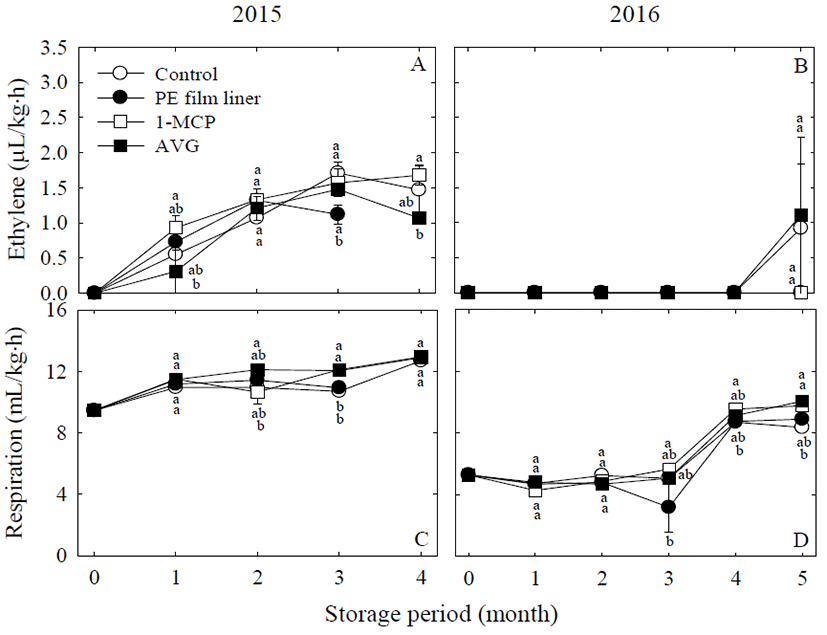
Ethylene production was not significantly affected at all treatments at different harvest dates. This result confirmed that very low and similar ethylene production was found at different harvest dates in ‘Rojo Brillante’ persimmon (10). Regarding different harvest dates, the production in respiration rate was different at their respective harvest time. In our study, early harvested fruits produced lower respiration rate than mature harvested fruits. The late harvested ‘Fuyu’ and ‘Hachiya’ persimmons produced more respiration rate than early harvested ones (11). In 2016, 1-MCP treatment produced more respiration rate at 4 and 5 month of storage compared with control and PE film liner treatments. However, in 2015, non-significant results were observed at all treatments. Due to the high accessibility and affinity of 1-MCP to the receptors, the effectiveness of 1-MCP application in persimmon can be varied (6). Application of 3 μL/L 1-MCP treatment in persimmon was suppressed ethylene production compared with control fruits (5). In pears, AVG did not block ethylene production sufficiently at low temperature (12). Respiration and ethylene production rate did not affect by 1-MCP and AVG treatments in different harvest dates may be due to the low concentration of the treatments.
PE film liner treatments maintained more significantly the weight loss during storage in both years compared with others (Fig. 2A, 2B). Whereas, the lowest weight loss was found in early harvested fruit treated with 1-MCP (Fig. 2B), followed by AVG and control (Fig. 2B). In addition, the firmness value of early harvested fruits was higher than that of mature harvested fruits and its decrease was slow in early harvested fruits (Fig. 2C, 2D), while its values of fruits (of 2015 and 2016) treated with AVG and 1-MCP was similar, but which were higher than control at the end of storage (Fig. 2C, 2D). The soluble solids contents (SSC) detected in the fruits (of 2015 and 2016) treated with 1-MCP were unstable at the early storage, and slightly decreased by 1 and 2 months after cold storage (Fig. 2E, 2F).
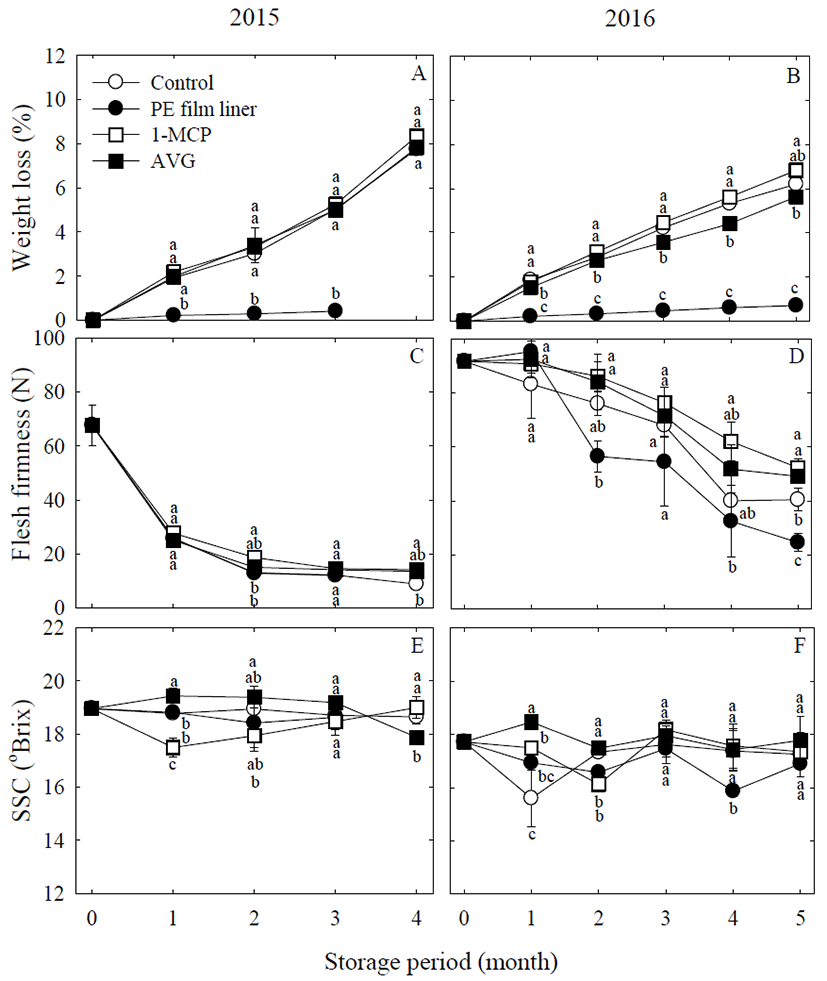
Variation of fruit peel color between the two different harvesting dates was significantly different because the color observed in early harvested fruits was brighter L* and b* than in mature harvested fruits. However, a* value in mature harvested fruits was significantly higher than in early harvested fruits (Fig. 3 and 4). On the other hand, variation of the fruit peel color observed in calyx-end region was significant compared to equatorial ones. In the calyx-end region, values of L* and b* in the fruits (of 2015 and 2016) treated 1-MCP were significantly higher than other treatments at the end of storage (Fig. 3A,E and 4A,E). The similar results were also observed in equatorial region of the fruits treated with AVG and 1-MCP (Fig. 3B,D,F and 4B,D,F). Although hunter a* value was observed as non-significant result at all treatments in 2016 (Fig. 3D, 4D), its significant declination was observed in PE film liner treatment, and which was less than those of other treatments in 2015 (Fig. 3C, 4C). In late harvested fruits, variation of the fruit peel color by PE film liner was significantly less than 1-MCP treatment in both regions starting from 3 month after storage to the end of storage (Fig. 3A-F).
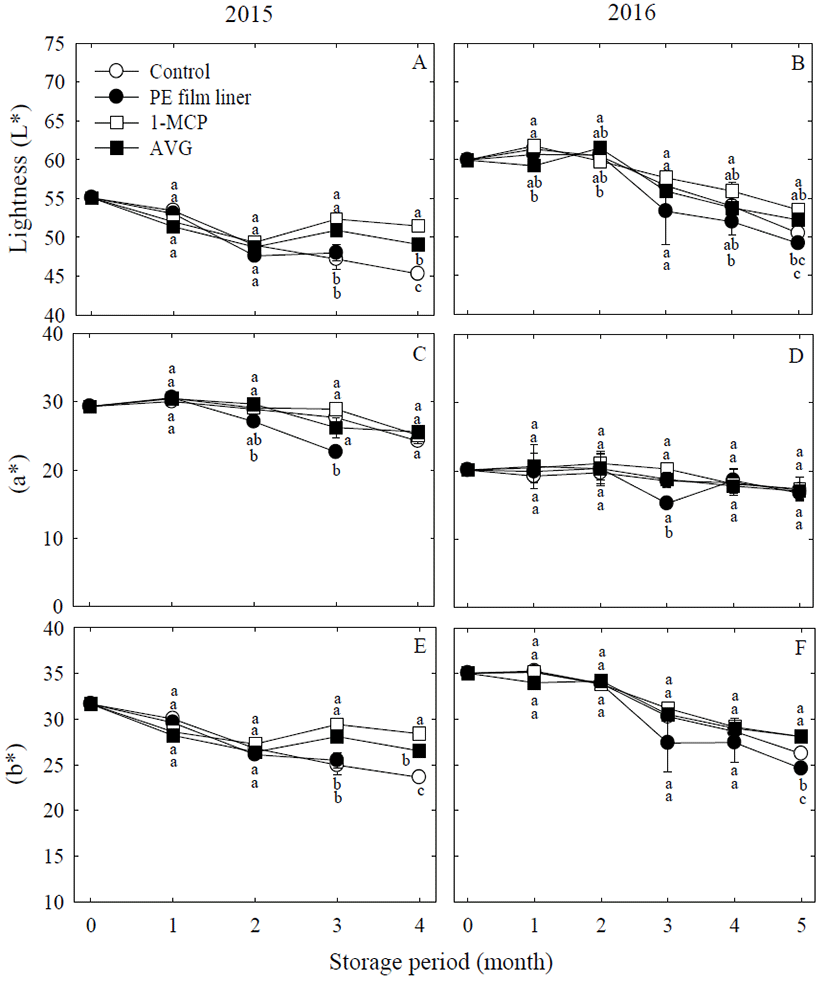
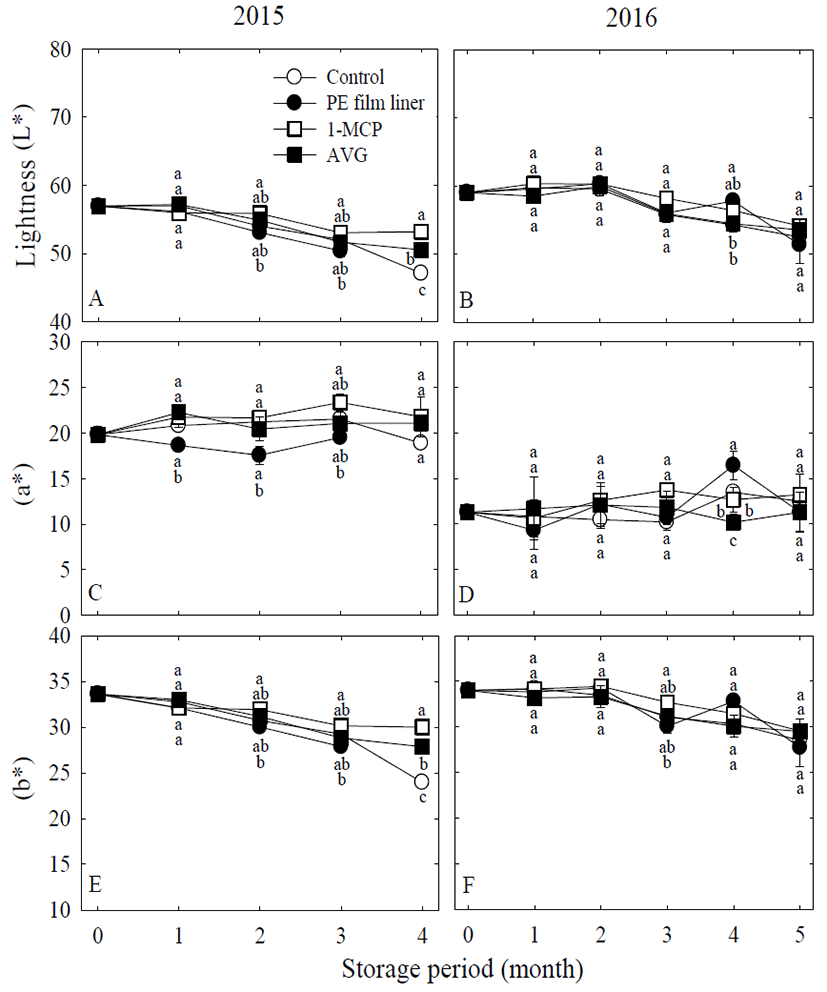
The flesh firmness is one of the important aspects to consider the quality attributes in persimmon fruits. Increase in cold storage period is directly correlated with decrease in flesh firmness. In ‘Rojo Brillante’ persimmon, the firmness which was lower than 10 N was not acceptable from a commercial point of view (13). In this experiment, the control in mature harvested fruits was found lower than 10 N at the end of storage in 2015. However, in 2016, the firmness value lower than 10 N was not observed at all treatments until the end of storage. According to different harvest dates, the firmness value of early harvested fruits was slowly decreased in this study. The firmness values of ‘Rojo Brillante’ persimmons picked at early harvested date were slowly declined at 1oC, compared with mature harvested fruits (10). 1-MCP and AVG treatments showed their effective results on maintaining decrease in firmness at different harvest dates.
PE film liner treatment was significantly delayed increase in weight loss and the same results were observed at different harvest dates, compared with other treatments. Storage with polyethylene bags reduced the weight loss in ‘Manila’ mango, compared with control or 1-MCP treatments alone (14). Increased weight loss was significantly suppressed when ‘Tonewase’ persimmon stored with polyethylene bags (15), and in apples (16). Application of 150 mg/L AVG to ‘Monroe’ peach did not reduce weight loss at 0℃ (17).
In this study, early harvested fruits had lower SSC, compared with mature harvested fruits. The SSC in different harvest dates was similar and found only little changes during cold storage (10). The unstable SSC was observed in 1-MCP treatment at early storage period in different harvest dates. Overall, non-significant was observed at all treatments during storage. Non-significant results in SSC were observed by AVG in ‘Tsugaru’ apple (9), and by 1-MCP in ‘Red Clapp’s’ pears (18) and in tomato (19). Lower SSC in fruit was associated with lower sucrose concentrations (20).
The differences on fruit peel color variables (L*, a*, and b*) between different harvest dates were observed at their harvest different time. Mature harvested fruits were strongly related to a* value and higher than early harvested fruits. Color index of a* value belonging to late harvest was found higher value at harvest than that belonging to early harvest (10). Peel color changes in ‘Sangjudungsi’ persimmons were significantly noticed in calyx-end regions than in equatorial ones (3), and the similar results were found in this study. 1-MCP treatment delayed skin color change in avocado (21) and inhibited anthocyanin increases in strawberry (22). Only 600 mg/L increased the L* value among three concentrations in ‘Red Chief’ apples (23). In this study, 1-MCP delayed decrease in peel color variables in calyx-end regions at both different harvest dates, compared with control and PE film liner treatments.
With increasing storage period, the incidence of storage physiological disorders was visually distinct. The incidence of peel blackening was distinctly noticed in control fruit (of 2015) after storage of 1 and 4 months (Fig. 5A), while fruit softening was observed in PE film liner treatment (Fig. 5C), In addition, the symptoms of decay were also observed in PE film liner treatment after storage of 3 months (Fig. 5E). However, no decay symptom was observed in the fruits (of 2016) treated with AVG treatment during storage, although PE film liner caused peel blackening at the end of cold storage (Fig. 5B), and softening after storage of 4 and 5 months (Fig. 5D). Incidence rate of softening and decay by control and PE film liner treatments were significantly higher (Fig. 5D), but those incidences were not observed in 1-MCP and AVG treatments throughout the storage period (Fig. 5F). The longer storage periods resulted in higher incidences of physiological disorders. Development of peel blackening was not highly occurred when the fruits were packed in 50 μm PE film bags (24). Peel blackening in 2016 was detected only in PE film liner treatment which may be packed with thin PE film bags. 1-MCP treatment significantly delayed fruit softening in this study, and the similar result was also found in ‘Tonewase’ and ‘Saijo’ persimmons (6). Higher amounts of decay fruits were observed highly in PE film liner treatment at 3 month in 2015 and at 4 month in 2016, compared with other treatments. No decay was observed in AVG treatment at different harvest dates and slightly found in 1-MCP treatment at 3 month in 2015. Decay incidence by 1-MCP treatment was detected after 90 days during air storage at 1℃ (25). However, decay incidence in early harvested fruits was higher than in late harvested ones at ‘Hachiya’ and ‘Fuyu’ persimmons (11), and the similar results were found in this study.
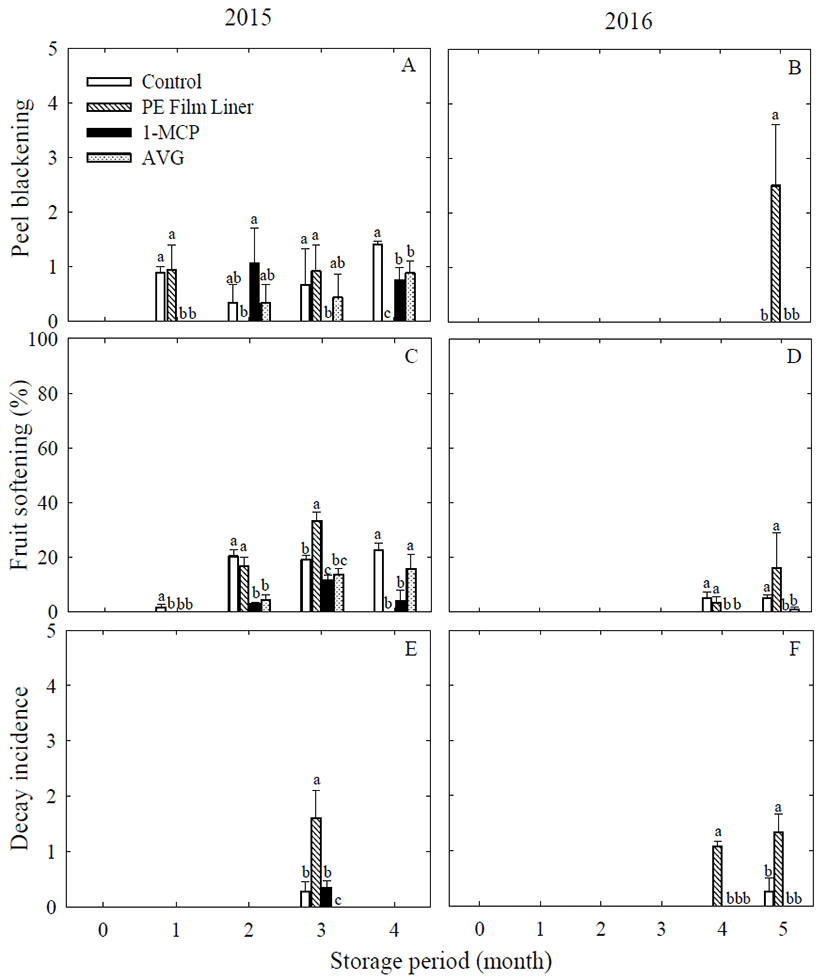
In the results, 1-MCP treatments delayed slowly decrease in flesh firmness, maintained in degradation of peel color variables and inhibited in occurring higher physiological disorders at both different harvest dates. On the other hands, PE film liner treatment was significantly decreased in flesh firmness, increased in disorders and declined results in peel color variables, compared with other treatments. Early harvested persimmons had better fruit quality attributes, decreased slowly in color variables and firmness, and delayed in storage disorders than mature harvested fruits.
Therefore, the results indicated that the importance of fruit maturity was closely related to different harvest dates and this study would provide a useful tool for postharvest handling and storability of ‘Sangjudungsi’ persimmon fruits during cold storage.
요 약
본 연구는 2015년과 2016년에 ‘상주둥시’ 감의 수확시기 를 달리하여 수확 후 PE필름, 1-MCP 및 AVG를 처리가 저온저장동안 과실의 품질에 미치는 영향을 조사하였다. 2016년 과실 수확시기는 2015년에 비하여 10일 빠른 조기 수확을 실시하였다. 과실의 에틸렌 발생 정도는 조기수확 한 과실들에서 현저히 낮았고, 과실의 경도는 저온저장동 안 1-MCP 처리구들이 다른 처리구의 과실에 비하여 높게 유지되었다. 과실의 감모율은 수확기를 달리한 모든 과실 들에서 PE 필름 처리 과실들에서 현저히 억제되었다. 성숙 기에 수확한 과실은 저온저장 중 과실의 꽃받침 부위과 경와부의 과피색(L* 및 b*) 변화를 보면 무처리와 PE필름 처리구에 비하여 1-MCP 처리구들이 그 변화정도가 낮았 다. 과실의 부패와 연화정도는 PE필름 처리 과실들에서 높게 나타났지만 AVG 처리구들에서는 부패과 발생이 없 었다. 그리고 조기수확한 과일은 성숙기에 수확한 과실에 비하여 경도가 높게 유지되었고, 과피색의 변화가 낮은 경 향을 보였고, 성숙기에 수확한 과실들은 당도, 과피의 적색 (Hunter a 값) 발현 및 호흡율이 높게 나타났다. 따라서 감 과실의 저장성 향상을 위해서는 조기수확이 중요한 요인으 로 작용하고 또한 수확 후 1-MCP 처리가 과일의 경도를 높게 유지하고 과피색의 변화를 억제하였으며, 과실의 감 모율은 PE 필름 처리에 의해 현저하게 억제됨을 확인하였 다.